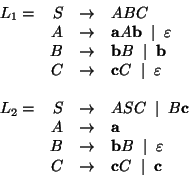That is, if
Proof:
We will prove that the languages are closed by creating the appropriate grammars.
Suppose we have two context-free languages, represented by grammars with start symbols
We have seen that the regular languages are closed under common set-theoretic
operations; the same, however, does not hold true for context-free languages.
Lemma: The context-free languages are closed under union, concatenation
and Kleene closure.
That is, if ![]() and
and ![]() are context-free languages, so are
are context-free languages, so are ![]() ,
,
![]() and
and ![]() .
.
Proof:
We will prove that the languages are closed by creating the appropriate grammars.
Suppose we have two context-free languages, represented by grammars
with start symbols ![]() and
and ![]() respectively.
First of all, rename all the terminal symbols in the second grammar so that
they don't conflict with those in the first. Then:
respectively.
First of all, rename all the terminal symbols in the second grammar so that
they don't conflict with those in the first. Then:
Lemma: The context-free languages are not closed under
intersection
That is, if ![]() and
and ![]() are context-free languages, it it not always true
that
are context-free languages, it it not always true
that ![]() is also.
is also.
Proof:
We will prove the non-closure of intersection by exhibiting a counter-example.
Consider the following two languages:

The intersection of these languages is:
Lemma: The context-free languages are not closed under
complementation.
That is, if ![]() is a context-free language, it it not always true
that
is a context-free language, it it not always true
that ![]() is also.
is also.
Proof: (By contradiction)
Suppose that context-free languages are closed under complementation.
Then if ![]() and
and ![]() are context-free languages, so are
are context-free languages, so are ![]() and
and ![]() .
Since we have proved closure under union,
.
Since we have proved closure under union,
![]() must also
be context-free, and, by our assumption, so must its complement
must also
be context-free, and, by our assumption, so must its complement
![]() .
.
However, by de Morgan's laws (for sets),
![]() ,
so this must also be a context-free language.
,
so this must also be a context-free language.
Since our choice of ![]() and
and ![]() was arbitarary, we have contradicted the non-closure
of intersection, and have thus proved the lemma.
was arbitarary, we have contradicted the non-closure
of intersection, and have thus proved the lemma.
![]()